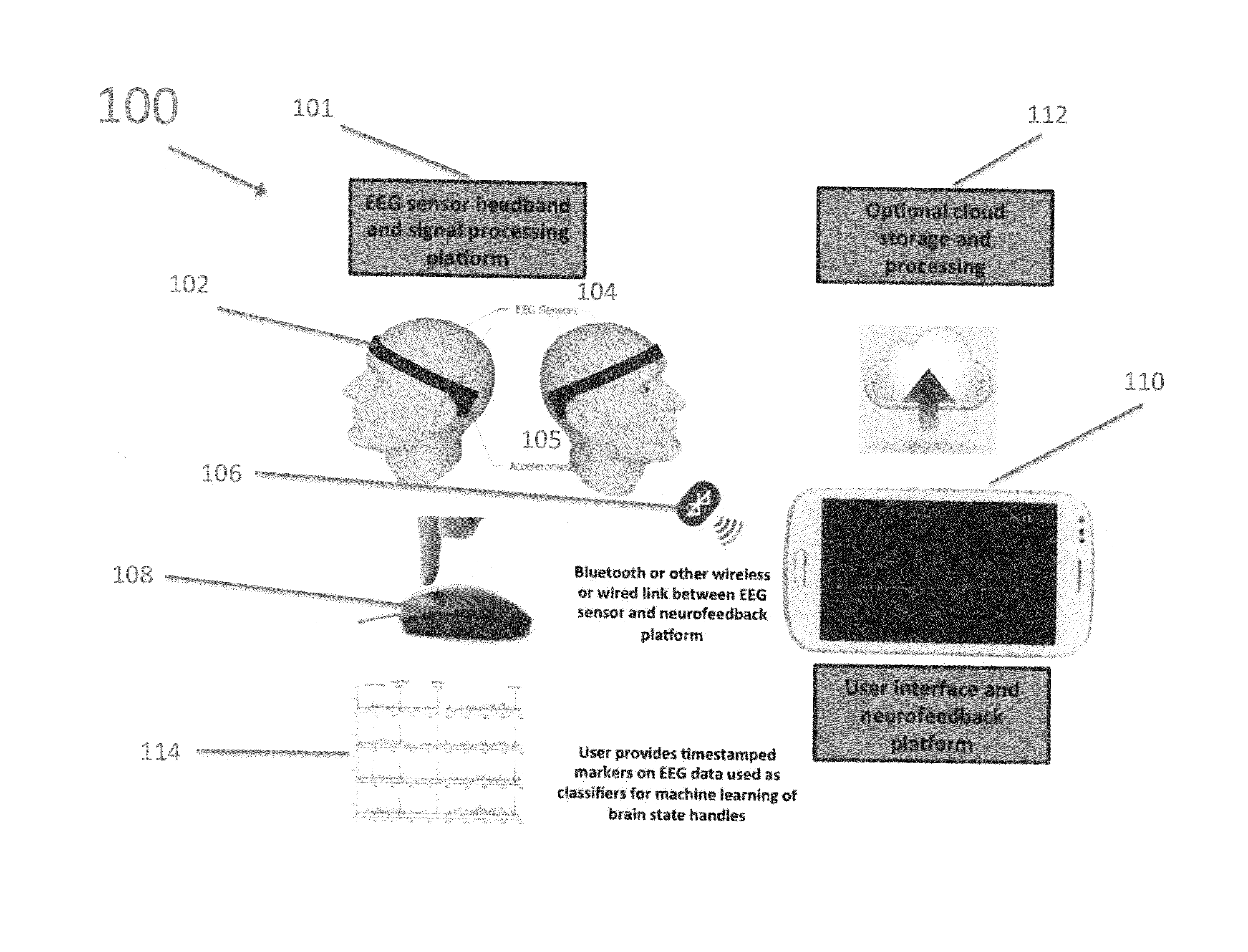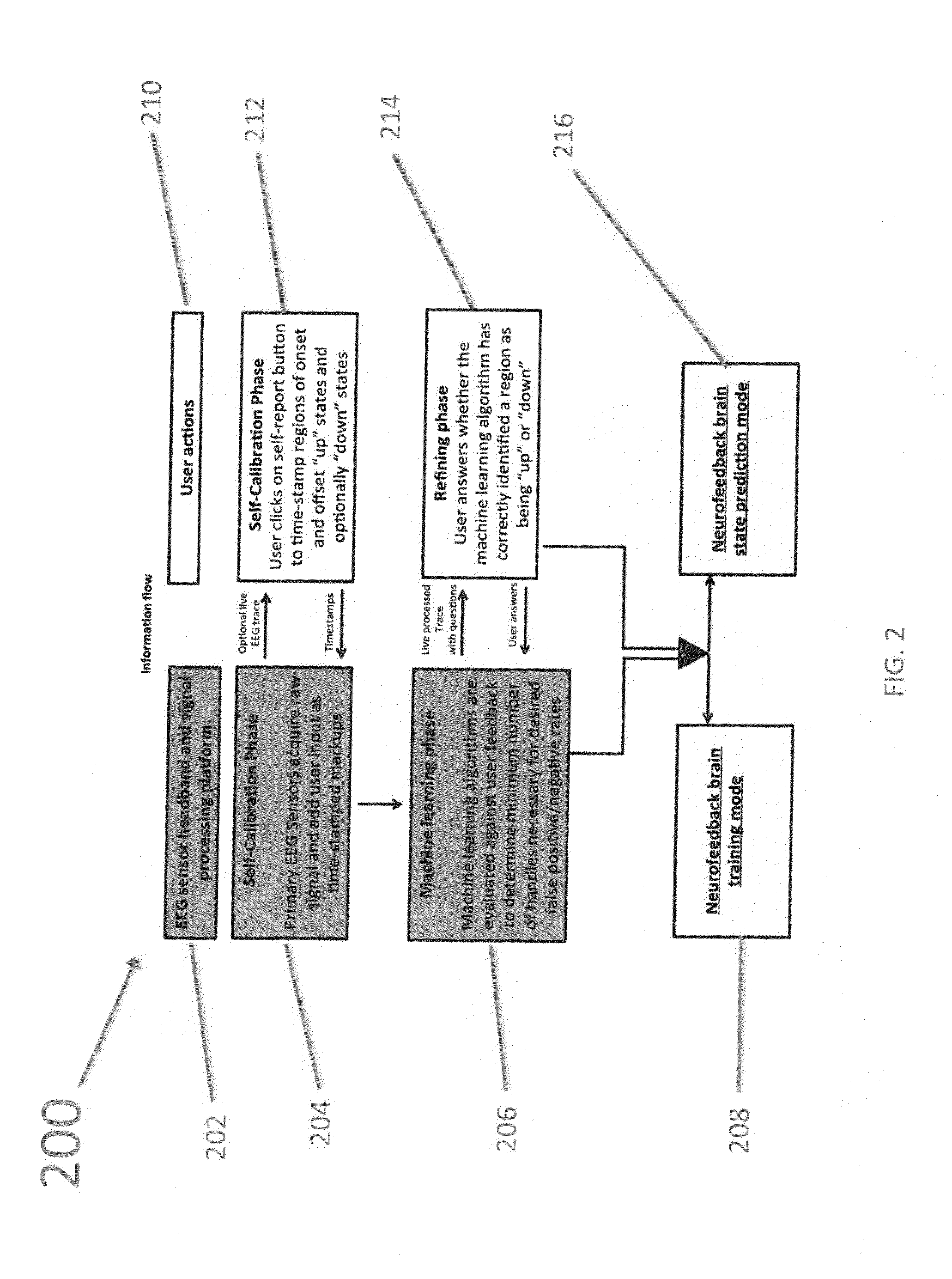Methods, Systems, and Apparatus For Self-Calibrating EEG Neurofeedback
a self-calibrating and neurofeedback technology, applied in the field of methods, systems and apparatus for self-calibrating eeg neurofeedback, can solve the problem that the robustness of self-reported perceptual states corresponding to extractable features in a person's own eeg data is not easily transferable to another person, and achieves low-computational overhead applications, sufficient data fidelity, and versatility and reliability.
- Summary
- Abstract
- Description
- Claims
- Application Information
AI Technical Summary
Benefits of technology
Problems solved by technology
Method used
Image
Examples
example feature extraction
Code
[0137]
%this file has outputs the features in a new file called%‘filename_feat’clear;clc;f = load(‘andreas_pain_2501’);%reminder Fs is 10 Hz for freq datafilename = strcat(f.filename,‘_feat’);k = 1;varNames = {‘label’, ... ‘alpha_LE’ ,‘alpha_LF’ ,‘alpha_RF’ ,‘alpha_RE’, ... ‘beta_LE’ ,‘beta_LF’ ,‘beta_RF’ ,‘beta_RE’ , ... ‘gamma_LE’,‘gamma_LF’,‘gamma_RF’,‘gamma_RE’, ... ‘delta_LE’,‘delta_LF’,‘delta_RF’,‘delta_RE’, ... ‘theta_LE’,‘theta_LF’,‘theta_RF’,‘theta_RE’ };observations = [ ];for t=1:size(f.alpha,1) if (~strcmp(f.label{t},‘unknown’)) response{k} = f.label{t}; row = [f.alpha(t,1) ... f.alpha(t,2) ... f.alpha(t,3) ... f.alpha(t,4) ... f.beta(t,1) ... f.beta(t,2) ... f.beta(t,3) ... f.beta(t,4) ... f.gamma(t,1) ... f.gamma(t,2) ... f.gamma(t,3) ... f.gamma(t,4) ... f.delta(t,1) ... f.delta(t,2) ... f.delta(t,3) ... f.delta(t,4) ... f.theta(t,1) ... f.theta(t,2) ... f.theta(t,3...
example neural
[0138]
function [cvalAccu, tvalAccu, ROC_class] =run_neural_classifier(X_train,T_train,X_test,T_test)%This function trains a neural network classifier and reports backcross-validation and test results.% Manipulate the data so that they are suitable for neural network%toolbox% We need now two matrices (arrays) input X and target T.% Input should have rows for features and columns for observations%(Feat × Obs).% Target should have 2 columns, one with 1's on pain and one with 1's%to no pain.% Choose a Training Function% For a list of all training functions type: help nntrain% ‘trainlm’ is usually fastest.% ‘trainbr’ takes longer but may be better for challenging problems.% ‘trainscg’ uses less memory. Suitable in low memory situations.trainFcn = ‘trainscg’; % Scaled conjugate gradient backpropagation.% Create a Pattern Recognition NetworkhiddenLayerSize = 10;net = patternnet(hiddenLayerSize,trainFcn);% Choose Input and Output Pre / Post-Processing Functions% For a list of all ...
example initial plotting
Code
[0139]
% This file plots random data from the file in different figures. It%might help on choosing the correct features. Run it in sections!% Use it only with new files.%% Data Inputclear;clc;% Choose filename from MuseRec / matfilename = ‘andreas_pain_2501’;f = load(sprintf(‘MuseRec / mat / %s’,filename));maxi = 0.2;mini = −0.2;%% Alpha frequenciesfigurehold onsubplot(6,1,1)plot(f.EEG_t,f.EEG(:,2))line([f.markers_t(1) f.markers_t(1)],[0 1682],‘color’,‘k’);line([f.markers_t(2) f.markers_t(2)],[0 1682],‘color’,‘k’);line([f.markers_t(3) f.markers_t(3)],[0 1682],‘color’,‘k’);line([f.markers_t(4) f.markers_t(4)],[0 1682],‘color’,‘k’);subplot(6,1,2)plot(f.alpha_t,mag2db(f.alpha(:,2)))subplot(6,1,3)plot(f.alpha_t,mag2db(f.beta(:,2)))subplot(6,1,4)plot(f.alpha_t,mag2db(f.gamma(:,2)))subplot(6,1,5)plot(f.alpha_t,mag2db(f.delta(:,2)))subplot(6,1,6)plot(f.alpha_t,mag2db(f.theta(:,2)))line([f.markers_t(1) f.markers_t(1)],[mini maxi],‘color’,‘k’);line([f.markers_t(2) f.markers_t(2)],[mini maxi],‘c...
PUM
 Login to View More
Login to View More Abstract
Description
Claims
Application Information
 Login to View More
Login to View More - R&D
- Intellectual Property
- Life Sciences
- Materials
- Tech Scout
- Unparalleled Data Quality
- Higher Quality Content
- 60% Fewer Hallucinations
Browse by: Latest US Patents, China's latest patents, Technical Efficacy Thesaurus, Application Domain, Technology Topic, Popular Technical Reports.
© 2025 PatSnap. All rights reserved.Legal|Privacy policy|Modern Slavery Act Transparency Statement|Sitemap|About US| Contact US: help@patsnap.com



